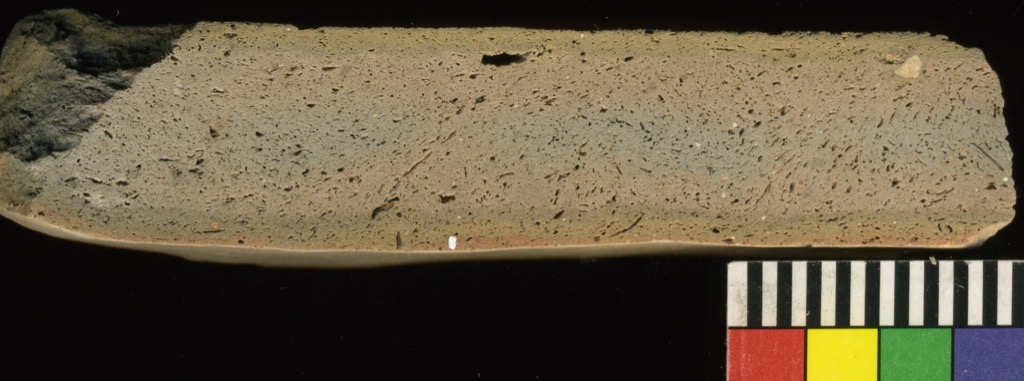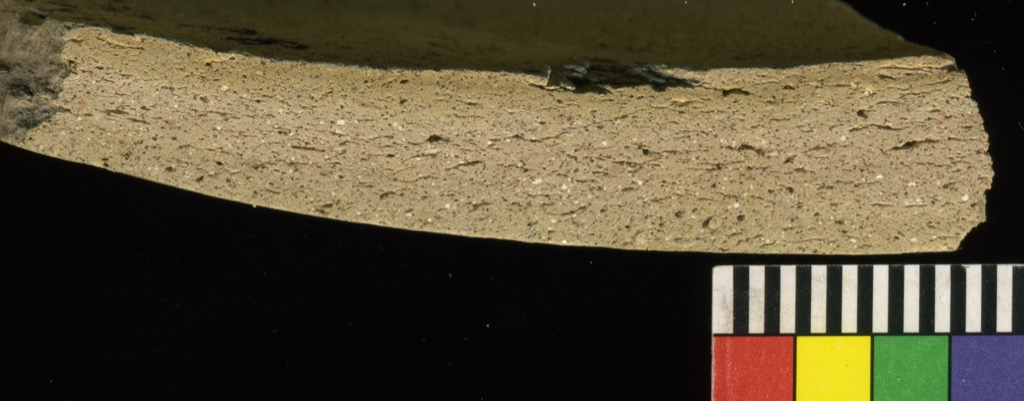Back to top: Chaff Temper Ware (CH)
General Description
Chaff tempered ware is defined by its visible chaff temper in the section. Small chaff holes are often visible on the surface of the sherds as well. The color is usually buff or a gray-buff, but occasionally can have light orange or a light red-orange color. These sherds can be decorated with incised, applique and painted decorations. CH is the most common ware in the Mozan corpus.
Note: Sherds coded HF (High Fired) are a type of Chaff Temper ware and can be considerecd to be part of this description.
Back to top: Chaff Temper Ware (CH)
Characteristics
Back to top: Chaff Temper Ware (CH)
Phase 3 - EDII/EDIII
This ware was almost non-existent in this Phase.
Back to top: Chaff Temper Ware (CH)
Phase 4 - Akkadian
| Basis for Definition |
Excavated in all Phases of the palace and strata above the palace. Identifying Attributes: much organic temper on exterior and interior, medium fired, some examples have signs of secondary burning. Vessels are mainly large to medium jars and medium and wide bowls. |
| Clay Type |
Fine, uniform particle size, color buff to very light orange, medium hardness. |
| Temper |
Large amounts of organic temper; vessels can also have some mineral inclusions. |
| Firing |
Medium, some examples from Phase 4 can have a light gray carbon core only in some parts of the vessel wall, especially in the thicker vessels and more often in the thicker areas near the base or rim. |
| Carbon core |
None. |
| Wall Thickness |
1-2 cm depending on vessel size. |
| Shapes |
Jars (size range: rim d ca 16-35cm).
Large deep bowls (size range: rim d ca 30-50cm).
Plates(size range: rim d ca 24-30cm).
|
| Surface Treatment |
Rough to coarsely wet smoothed. |
| Decoration |
Can have incised and/or rope decoration. |
| Comments |
This ware is very common in the mid Akkadian through the end of the third millennium; it is, along with Wet Smooth (in ED III and early Akkadian strata), the ware that is used most frequently for the manufacture of large jars and large to medium bowls. It is made from the same paste as the Wet Smoothed ware except that 1) jar and bowl shapes are different, 2) the surface is coarser due to the addition of chaff and 3) the exterior of the vessels have not been as finely smoothed resulting in chaff holes on the surface. |
Back to top: Chaff Temper Ware (CH)
Phase 4 Sherd Illustrations
Back to top: Chaff Temper Ware (CH)
Exteriors
Back to top: Chaff Temper Ware (CH)
Interiors
Back to top: Chaff Temper Ware (CH)
Sections
Back to top: Chaff Temper Ware (CH)
Phase 5 - UrIII/Isin-Larsa
| Clay Type |
Clay more compact than in Phase 4. |
| Temper |
Much chaff. Beginning of calcite temper added to clay, previously some calcite but probably already present in the clay matrix; some black lithic temper (probably Feldspar or Quartz). |
| Firing |
Consistently higher fired than Phase 4. Can have carbon core but not common and when present usually faint. |
| Color |
Most clays fire buff or gray-buff but some can fire light orange or light red-orange. |
| Wall Thickness |
Many examples thinner walled than in Phase 4. |
| Decoration |
Incised decoration continues marginally into Phase 5c; in some shapes ribs on bodies and on top of rims occur especially in Phase 5h. |
Back to top: Chaff Temper Ware (CH)
Phase 5 Sherd Illustrations
Back to top: Chaff Temper Ware (CH)
Exteriors
Back to top: Chaff Temper Ware (CH)
Interiors
Back to top: Chaff Temper Ware (CH)
Sections

A16q852-p14 |

A16q899-p8 |
#### Phase 6 - Khabur
Typical Khabur type decoration can occur on vessels made in any ware type.
| Temper |
Much chaff, more black lithic inclusions (Quartz or Felspar) that can be quite small in size giving the matrix a "gritty" feeling. Can have calcite added. Lithic temper the size of sand and larger. |
| Firing |
Can have carbon core; in this period the type with a heavy black carbon core begins. |
| Color |
Both buff firing clay and light orange firing clay used. |
| Manufacturing Techniques |
Cracks and fissures in the clay, a result of inadequate clay preparation, are more common. "Stretch" marks caused by air pockets. |
| Decoration |
Typical Khabur period painted decoration. |
#### Phase 6 - Sherd Illustrations
#### Phase 7 - Mittani
Typical Mittani painted decoration can be applied to any ware type. CH in this phase occur in three main groups, Group 1 is the standard with Groups 2 and 3 the variations.
Sub-Group 1: Main group.
| Temper |
Continues the "gritty" texture because of the large amount of sand added, much chaff but often smaller pieces than earlier. Lithic pieces are larger but more widely scattered. Some sherds have rehydrated calcite on the surface. |
| Firing |
More sherds have a carbon core. |
| Color |
Reddish firing clay but more rarely can be made in gray-buff firing clay. |
| Decoration |
Can be painted with typical Mittani designs but more often unpainted. |
#### Phase 7 - Sub-group 1 Sherd Illustrations
##### Exteriors
##### Interiors
##### Sections
Sub-Group 2: Light Gray carbon core.
| Temper |
Chaff and lithic inclusions as in Group 1 above. |
| Firing |
Medium to high. |
#### Phase 7 Sub-Group 2 Sherd Illustrations {#7sherds}
##### Exteriors
##### Interiors
##### Sections
Sub-Group 3: Dark Gray carbon core.
| Temper |
Chaff larger than in Groups 1 or 2 and occurs in both long narrow and sub-round shapes. Few lithic inclusions. When calcite present in larger forms it is often rehydrated on the surface. |
| Firing |
Higher fired than groups 1 or 2, even if these sherds have a dark carbon core. |
#### Phase 7 - Sub-Group 3 Sherd Illustrations
##### Exteriors
##### Interiors
##### Sections
#### Phase 8 - Middle Assyrian Period
| Temper |
More sand than in the Mittani CH ceramics and therefore the sherds are heavier due to this sand content. The result is that medium sized vessels, even when empty, would be difficult to carry. Calcite and brown-yellow lithic temper not well mixed. Sub-round chaff holes.
|
| Surface Treatment |
One class of deep bowls has a red-brown slip applied that can be burnished on top of the rim and on the exterior. |
| Shapes |
Many deep bowls and cooking vessels have a slight interior lip which in some cases would hold a lid but in others is too narrow to perform this function effectively. |
| Comments |
One type variation is close to Group 1 in the Mittani period but has a yellow-buff slip on the exterior and more red-brown color from the slip applied on the interior. In this variation the interior and rim are burnished but the exterior is smoothed only. |
Back to top: Chaff Temper Ware (CH)